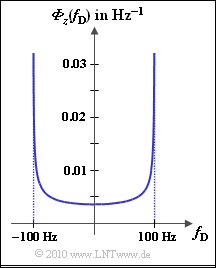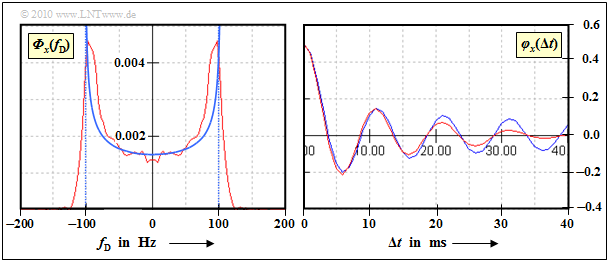Difference between revisions of "Aufgaben:Exercise 1.5: Reconstruction of the Jakes Spectrum"
m (Text replacement - "[[Signaldarstellung/" to "[[Signal_Representation/") |
m (Text replacement - "[[Stochastische_Signaltheorie/" to "[[Theory_of_Stochastic_Signals/") |
||
| Line 26: | Line 26: | ||
''Notes:'' | ''Notes:'' | ||
* This task belongs to the subject area [[Mobile_Communications/Statistische_Bindungen_innerhalb_des_Rayleigh%E2%80%93Prozesses|Statistische Bindungen innerhalb des Rayleigh–Prozesses]]. | * This task belongs to the subject area [[Mobile_Communications/Statistische_Bindungen_innerhalb_des_Rayleigh%E2%80%93Prozesses|Statistische Bindungen innerhalb des Rayleigh–Prozesses]]. | ||
| − | * The digital filter is treated in detail in chapter [[ | + | * The digital filter is treated in detail in chapter [[Theory_of_Stochastic_Signals/Digitale_Filter|Digitale Filter]] of the book „Stochastic Signal Theory”. |
Revision as of 10:52, 9 July 2020
In a mobile radio system, the Doppler effect is also noticeable in the power density spectrum of the Doppler frequency $f_{\rm D}$ .
This results in the so-called Jakes spectrum, which is shown in the graph for the maximum Doppler frequency $f_{\rm D, \ max} = 100 \ \rm Hz$. ${\it \Phi}_z(f_{\rm D})$ has only portions within the range $± f_{\rm D, \ max}$, where $${\it \Phi}_z(f_{\rm D}) = \frac{2 \cdot \sigma^2}{\pi \cdot f_{\rm D, \hspace{0.05cm} max} \cdot \sqrt { 1 - (f_{\rm D}/f_{\rm D, \hspace{0.05cm} max})^2} } \hspace{0.05cm}.$$
What is expressed in the frequency domain by the power spectral density (PSD) is described in the time domain by the autocorrelation function (ACF). The ACF is the ${\it \Phi}_z(f_{\rm D})$ by the inverse Fourier transform of the PSD.
With the Bessel function of the first kind and zero order $({\rm J}_0)$ you get $$\varphi_z ({\rm \Delta}t) = 2 \sigma^2 \cdot {\rm J_0}(2\pi \cdot f_{\rm D, \hspace{0.05cm} max} \cdot {\rm \Delta}t)\hspace{0.05cm}.$$
To take into account the Doppler effect and thus a relative movement between transmitter and receiver in a system simulation, two digital filters are inserted in the Rayleigh channel model, each with the frequency response $H_{\rm DF}(f_{\rm D})$.
The dimensioning of these filters is part of this task.
- We restrict ourselves here to the branch for generating the real part $x(t)$. The ratios derived here are also valid for the imaginary part $y(t)$.
- At the input of the left digital filter of the Rayleigh channel model , there is white Gaussian noise $n(t)$ with variance $\sigma^2 = 0.5$.
- The real component is then obtained from the following convolution
- $$x(t) = n(t) \star h_{\rm DF}(t) \hspace{0.05cm}.$$
Notes:
- This task belongs to the subject area Statistische Bindungen innerhalb des Rayleigh–Prozesses.
- The digital filter is treated in detail in chapter Digitale Filter of the book „Stochastic Signal Theory”.
Questionnaire
Sample solution
- $${\it \Phi}_x(f_{\rm D} = 0) = {\it \Phi}_y(f_{\rm D} = 0) = \frac{{\it \Phi}_z(f_{\rm D} = 0)}{2}= \frac{\sigma^2}{\pi \cdot f_{\rm D, \hspace{0.05cm} max}} = \frac{0.5}{\pi \cdot 100\,\,{\rm Hz}} \hspace{0.15cm} \underline{ = 1.59 \cdot 10^{-3}\,\,{\rm Hz^{-1}}} \hspace{0.05cm}.$$
(2) Solution 2 is correct:
- The input signal $n(t)$ has a white (constant) LDS ${\it \Phi}_n(f_{\rm D})$.
- The PSD at the output is then
$${\it \Phi}_x(f_{\rm D}) = {\it \Phi}_n(f_{\rm D}) \cdot | H_{\rm DF}(f_{\rm D}|^2 \hspace{0.05cm}.$$
(3) Solution 3 is correct.
- Only if this condition is fulfilled, the signal $x(t)$ has the same variance $\sigma^2$ as the noise signal $n(t)$.
(4) No:
- The two conditions after subtasks (2) and (3) only refer to the magnitude of the digital filter.
- There is no constraint for the phase of the digital filter.
- This phase can be chosen arbitrarily. Usually it is chosen in such a way that a minimum phase network results.
- In this case, the impulse response $h_{\rm DF}(t)$ then has the lowest possible duration.
The graph shows the result of the approximation. The red curves were determined simulatively over $100\hspace{0.05cm}000$ samples. You can see:
- The Jakes power spectral density (left graph) can only be reproduced very inaccurately due to the vertical drop at $± f_{\rm D, \ max}$.
- For the time domain, this means that the ACF decreases much faster than theory suggests.
- For small values of $\delta t$, however, the approximation is very good (right graph).

